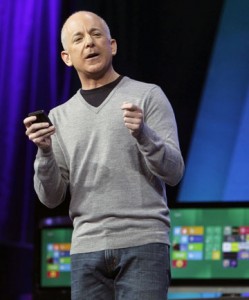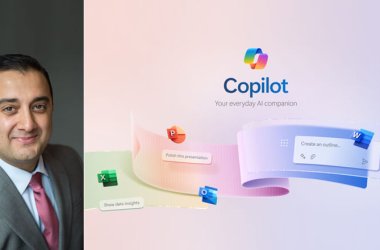
Microsoft yesterday released its “Consumer Preview” of Windows 8, and before Windows president Steve Sinofsky finished his presentation to reporters at Mobile World Congress 2012, downloads had begun in 70 countries.
This release is the first that non-developers can get their hands on. And “hands on” is literal: Windows 8 fluidly combines keyboard, mouse, and touch: end users can use all three interchangeably, moving apparently effortlessly between them. One of the Microsoft presenters talked about her experience of learning new ways to interact with her various computers, using a keyboard in some cases, but finding a growing numbers of ways to interact with touch.
The demonstration laid great stress on the PC and the power and value of the Windows OS. But Windows 8 is clearly targeted at the exploding market for ultrabooks and tablets – for a new world of mobile computing, cloud services, always-on social networks, and pervasive wireless networks that combine cellular, Wi-Fi, Bluetooth, and near field communications.
As the Consumer Preview name implies, this announcement was focused on Windows 8 for end users. But Sinofsky said that Microsoft will detail the enterprise features preserved and created for Windows 8 at the upcoming CeBIT show in Hannover, Germany in March.
Something like 20 device prototypes or reference designs were on display from Microsoft chip and OEM partners, but no one from the audience was allowed to touch them afterwards. The diversity was striking: for the first time, Windows is running on non-Intel silicon: the ARM processor. ARM partners for Windows 8 are Nvidia, Texas Instruments and Qualcomm.
The full suite of Microsoft Office 15 applications was showcased on the ARM devices, underlying the fact that Windows 8 on ARM will not be a compromise.
The devices themselves ranged from an 82-inch flat panel display, through an array of ultrabooks, convertibles, and tablets. Most of them featured small bezels to create a sense of seamless encompassing touch surface. Thin is in: some of the device makers had to figure out innovative ways to incorporate full-size peripheral ports in cases that were thinner than full-size ports. Some were in gleaming black plastic, others were metal. Vendors included Dell, Lenovo, Acer, HP, Samsung and Intel itself.
“This is Windows, re-imagined,” an ebullient Sinofsky declared, repeating a phrase sounded when the Developer Preview of Windows 8 was unveiled about five months ago. This time, it seemed justified. He said over 100,000 changes had been made for the Consumer Preview.
The most striking difference is the new user interface, Metro, based on the radically different user interface originally designed for Microsoft’s re-launched mobile OS, Windows Phone.
Gone, or more accurately initially invisible, is the classic Windows Desktop. Instead, the Metro Start page shows the distinctive collection of brightly colored square and rectangular “tiles”, each one representing an app or service. The tiles combine with another unique Metro feature: a strong reliance on text and typography to communicate and guide. These tiles can be swapped and moved, and the screens of the PCs and tablets that will host Windows 8 create a much larger surface to organise your space. Each tile is “live” that is linked with notifications and other state changes to show continually updated information, such as a new email or Facebook update.
The Windows Desktop is still accessible, and can run onscreen side by side with pure Metro style apps.
A wide range of Microsoft apps have been Metro-cised and all partake of another key attribute of Windows 8: “contracts,” which are a way for Windows 8 applications to automatically share information with each other. It’s an important part of Microsoft’s effort to make Windows 8 a platform that almost intuitively lets users integrate information. Within every Metro app, a user has a built-in search option for that app, without exiting to a separate browser.
A full-screen feature will cause a Metro app to fill up the entire display. A set of “charms” or icons can be pulled out from the side to take additional actions. The collection of apps, data, settings and personalisation in effect “follows” a user as he moves from a desktop computer to a notebook or a tablet.
Windows 8 offers a SkyDrive app, giving a Metro style interface to Microsoft’s online storage and sync service. Windows 8 treats local and cloud storage seamlessly: one demo showed a user quickly attaching photos from SkyDrive and a local disk and sending them in an email.
Windows 8 is smaller than Windows 7, it runs fewer processes and threads, and there’s closer resource management of background apps to optimise the user experience. The goal is to streamline Windows, and make it at the same time both tougher and more fluid, according to Microsoft. One laptop went from a cold start to full screen ready to use in just under eight seconds. The OS senses when you’re not using an app and puts it to sleep, waking instantly when you return to it. The system itself wakes from sleep almost instantly.
A new concept of a “class driver” makes it much easier to simply plug in a new peripheral, and have it recognised and ready to run, without the current delays as the OS searches for and installs additional drivers.
Also demonstrated was Windows to Go: a USB stick with the full Windows 8 implementation was plugged into a notebook loaded with Windows 7, and started. Windows 8 booted just as quickly as it did on the bare metal, and coexists with Windows 7.
Microsoft has opened the previously announced Windows Store where users can download Metro apps. During the Consumer Preview phase, all apps will be free, the company said. The store home page features a ‘spotlight’ space at left for featured apps, and to the right categories or classes of apps which can be drilled into for details.
Sinofsky didn’t give a firm date for general availability of the final OS. He did say Microsoft has moved into the next stage – moving toward Release Candidate, to be followed by release to manufacturing, and shortly thereafter, general release. The expectation still is that Windows 8 will be released well before the end of 2012.
Check out the Windows 8 consumer preview on http://www.youtube.com/watch?v=of3XMFd5cE8&feature=related





